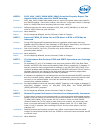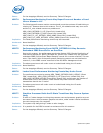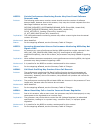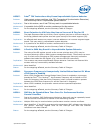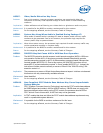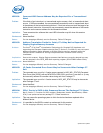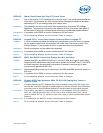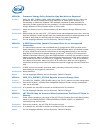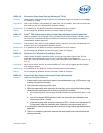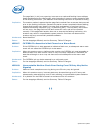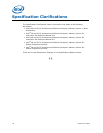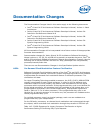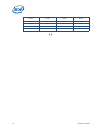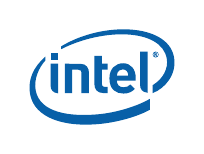
Specification Update 45
HSD113. Processor May Hang During Package C7 Exit
Problem: Under certain internal timing conditions, the processor might not properly exit package
C7 leading to a hang.
Implication: Due to this erratum, the package C7 state may not be reliable. Intel has not observed
this erratum with any commercially available system.
Workaround: It is possible for the BIOS to contain a workaround for this erratum.
Status: For the steppings affected, see the Summary Table of Changes.
HSD114. Intel
®
TSX Instructions May Cause Unpredictable System behavior
Problem: Under a complex set of internal timing conditions and system events, software using
the Intel TSX (Transactional Synchronization Extensions) instructions may observe
unpredictable system behavior.
Implication: This erratum may result in unpredictable system behavior. Intel has not observed this
erratum with any commercially available system.
Workaround: It is possible for the BIOS to contain a workaround for this erratum.
Status: For the steppings affected, see the Summary Table of Changes.
HSD115. Spurious LLC Machine Check May Occur
Problem: Under certain stressful conditions while running at ring ratios higher than 30, the
processor may experience a spurious LLC machine check as indicated by
IA32_MCi_STATUS.MCACOD (bits [15:0]) with value 000x 0001 0000 1010 (where x is
0 or 1).
Implication: When this erratum occurs, an uncorrectable LLC error will be logged and the system
may hang or restart.
Workaround: It is possible for the BIOS to contain a workaround for this erratum.
Status: For the steppings affected, see the Summary Table of Changes.
HSD116. Page Fault May Report Incorrect Fault Information
Problem: Under the following conditions:
1. A read-modify-write instruction’s memory source/destination (e.g., ADD memory, reg)
crossing a cache line boundary.
2. That instruction executing without fault.
3. While the read-modify-write instruction is executing, one or more of the following page
table attributes associated with its memory operand are modified:
a. the D (dirty) flag was 0 when the instruction was initiated but was concurrently set to 1, and/
or
b. one of the relevant R/W flags was 0 when the instruction was initiated but was
concurrently set to 1, and/or
c. if the read-modify-write instruction executes at CPL = 3 and one of the relevant U/
S flags was 0 when the instruction was initiated but was concurrently set to 1.
4. A subsequent instruction executing within a narrow timing window that experiences a
page fault
5. There is no serializing instruction between the read-modify-write instruction and the
faulting instruction.



